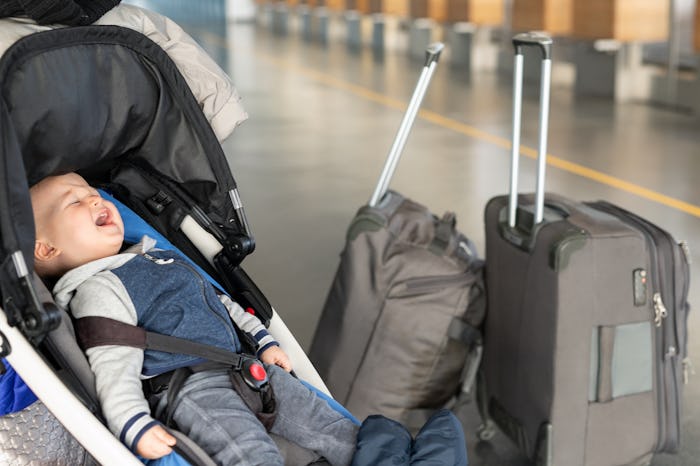Life

These Tricks Will Help You Get Your Baby To Sleep When You're Traveling For The Holidays
Taking a trip for the holidays, or heading to visit family? Then you’re probably already planning how to get your baby to sleep while traveling. But stress no more — two experts shared tried and true techniques with Romper about how to get little ones a-snoozin’ no matter where they are. Ultimately, it’s about making their sleeping arrangements feel as much like home as possible.
Lynelle Schneeberg, Psy.D., pediatric sleep psychologist, author of Become Your Child’s Sleep Coach, and director of the Behavioral Sleep Program at Connecticut Children's Medical Center, told Romper in an interview exactly why babies and toddlers have a hard time sleeping away from home. It’s the same reason adults do when they’re in an unfamiliar place: a concept called sleep onset association.
“For sleep onset to occur, you have a set of associations that usually go along with that. Adults have it — you probably like a certain side of the bed, a certain number of lights on or off in your room, et cetera. When you travel, the bottom line is you’re trying to keep those sleep associations, and you want to keep them as similar as possible,” she explains. “Anything you can bring from home that smells the same or sounds the same — a white noise machine, blankets, security objects like teddy bears, the books you like to read — would also help.”
For this reason, it’s important to think about what babies usually have in the room while sleeping, what their environment is like, and how you can recreate that on the road. Christine Stevens, children's sleep consultant and owner of Sleep Solutions by Christine, shared some of her tips for replicating baby’s bedroom in an interview with Romper.
“Make the place where baby sleeps similar to what you have at home. Take the baby's sleep sack if you use one, make sure the room is dark, take baby's lovey if he or she uses one, and have a space just for baby to sleep in, such as a Pack N' Play or portable crib,” she says.
Schneeberg adds that she has heard of parents using their hotel room’s bathroom or closet as their baby’s bedroom so it can be dark and quiet. Keeping bedtimes and bedtime routines the same also helps. Just like they get you ready for bed literally, they also tell your brain it’s time to shut off. Little ones are no different.
“With toddlers, maybe you always have a snack, then you do your washing up, then you brush your teeth, have your two books, and then we go to sleep,” says Schneeberg. “These steps still cue drowsiness away or at home. They do the job for you when you’re away.”
It can also help to start your baby sleeping in the Pack N’ Play or getting naps in while in the stroller before traveling. The more familiar your baby can be with their travel setup ahead of time, the easier it will be for them to fall asleep on the road.
“You are literally practicing, and it won’t be the first time the baby has ever slept in that setting,” says Schneeberg.
But for some parents, the sleep troubles begin before they even get to their destination. Long road trips or plane rides can also present a problem for getting babies to sleep enough.
“When you're in transit, sleep rules can be very flexible,” says Stevens. “Do whatever you have to do to get baby to sleep; it will make the trip less stressful on both you and baby. Take toys for baby to play with and snacks to keep baby occupied.”
If your baby requires a lot of help to fall asleep in transit, Schneeberg recommends working on their ability to fall asleep alone before your next big trip. “Something to keep in mind for the future: teach your child to self soothe on a safe surface. Then you’re going to have a kid who can sleep anywhere.”
Parents may be wondering if keeping little ones awake through their usual naptimes could ensure they’re ready to sleep come bedtime. Both Schneeberg and Stevens agree this can backfire, and recommend keeping nap schedules as similar as possible to when you’re at home.
“We have a phrase in sleep medicine that ‘sleep begets sleep,’ meaning it’s better to keep the naps in place if you can swing it,” Schneeberg says. “Unlike adults, kids who are sleep deprived get more hyperactive than fatigued. If you can do a stroller nap or car nap and keep somewhat of a schedule, that can be very useful. Having said that, your family should still try to have a good time. Life doesn’t always fall into scheduled patterns.”
And when it’s time to pack up and head home, Stevens says to go right back to your usual routine.
“The biggest thing to remember with trips and holidays is that when you get home from your trip, that first night, get back to your old routine. Within a few nights, baby will be used to being home again and adjusted back.”
Experts:
Lynelle Schneeberg, PsyD, pediatric sleep psychologist, author of Become Your Child’s Sleep Coach, and director of the Behavioral Sleep Program at Connecticut Children's Medical Center
Christine Stevens, children's sleep consultant and owner of Sleep Solutions by Christine
This article was originally published on